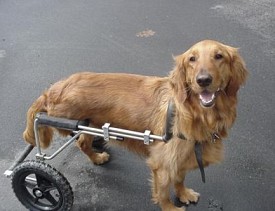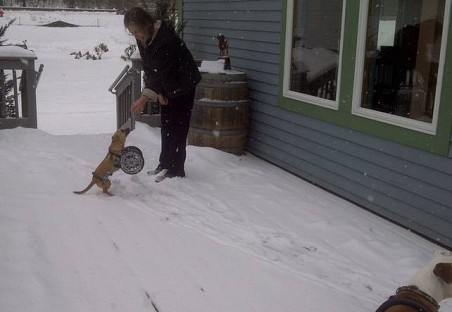Eddie's Wheels: Freedom for Disabled Dogs
 If your dog has become injured or is experiencing a disability that affects his ability to walk, Eddie's Wheels has the answer.
If your dog has become injured or is experiencing a disability that affects his ability to walk, Eddie's Wheels has the answer.
Eddie Grinnell, owner of Eddie's Wheels, is a mechanical engineer by trade. After his companion Doberman, Buddha, was injured and became partially paralyzed in 1989, Grinnell (finding no other help available) invented his first attachable cart for his dog. Since then, Eddie's Wheel's has grown to manufacture carts, harnesses, and wheelchairs for dogs, which are used worldwide.
At his home in Shelburne, MA, I had the opportunity to meet a few of Eddie Grinnell's dogs. all of whom have paralysis or loss of either front or hind legs – and all of whom are energetic, healthy, and happy to trot around with their carts attached. Eddie and his wife Leslie, who has been working with disabled dogs for over 20 years, explained the modifications you might need in your home to accommodate a disabled dog.
Modifying Doorways for a Disabled Dog
"Everything we make will fit through a standard-sized door," states Eddie Grinnell. He adds that even if the dog is very large, he modifies their basic design to be just narrow enough to fit through any door, so that you don't have to bring your dog in through the garage door. Even if you have raised thresholds or strips in your doorways, the dogs can go over them easily with the carts.
Naturally, just as you would for humans, you will want to have relatively clear paths for the dog. The dogs don't stay harnessed to the carts at all times, so you need to have a safe enclosed area for them when you are not home.
Setting Up Ramps for Disabled Dogs
Similarly to modifications for humans in wheelchairs, ramps of varying sizes can be built to accommodate your pet. Since the ramps are not attached to the dwelling, Eddie Grinnell mentions that you are not required to get a permit to build ramps for your pets.

Grinnell explains the general formula to building ramps. If, for example, your steps have a 20 inch rise, you need to angle the ramp 1 inch per foot, creating a ramp that is 20 feet long. "Some dogs have really good upper-body strength and you might be able to get away with a ten-foot ramp."
A traction compound or strips of sandpaper that come with a sticky backing can be applied to the ramps to create better traction for the dogs.
If the dog has only minor difficulty walking, he recommends plastic or wooden steps (available at most large pet stores) to allow the pet to travel more easily around the house.
Managing Inclement Weather and Dogs on Wheels
Eddie Grinnell claims that his carts are made to withstand wet weather and will not cause the dog any chafing. When dealing with snow, Leslie Grinnell says that they simply shovel the ramps and the dogs have no problem navigating a snowy surface. "We never use deicers. We don't put down salt; it'll hurt their pads. We just use sand."

Dogs' Adjustment to Eddie's Wheels
Leslie Grinnell tells us that the carts allow the dog to "get back to a normal dog stance."
"If they can't walk, it's really easy. They just take off once you have the cart attached. If they can walk a little, then there may be a little more adjustment time," comments Eddie Grinnell.
Do you have a disabled dog? Do you think Eddie's Wheels is a good idea? We want to hear YOUR stories. We love to hear about YOU!
Cris Carl writes for Networx.
Updated July 18, 2018.
Looking for a Pro? Call us (866) 441-6648

Remodeling Average Costs
Remodeling Contractors Experiences

Time To Replace The Heat Pump – Before It Broke Down Completely

All Our New Home’s Electrical Work Done By One Skilled Contractor



